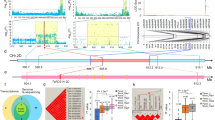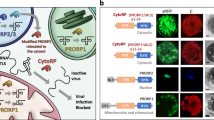Abstract
As the processing mechanism of all known potyviruses involves the activity of cysteine proteinases, we asked whether constitutive expression of a rice cysteine proteinase inhibitor gene could induce resistance against two important potyviruses, tobacco etch virus (TEV) and potato virus Y (PVY), in transgenic tobacco plants. Tobacco lines expressing the foreign gene at varying levels were examined for resistance against TEV and PVY infection. There was a clear, direct correlation between the level of oryzacystatin message, inhibition of papain (a cysteine proteinase), and resistance to TEV and PVY in all lines tested. The inhibitor was ineffective against tobacco mosaic virus (TMV) infection because processing of this virus does not involve cysteine proteinases. These results show that plant cystatins can be used against different potyviruses and potentially also against other viruses, whose replication involves cysteine proteinase activity.
This is a preview of subscription content, access via your institution
Access options
Subscribe to this journal
Receive 12 print issues and online access
$209.00 per year
only $17.42 per issue
Buy this article
- Purchase on Springer Link
- Instant access to full article PDF
Prices may be subject to local taxes which are calculated during checkout



Similar content being viewed by others
References
Riechmann, J.L., Lain, S. & Garcia, J.A. Highlights and prospects of potyvirus molecular biology. J. Gen. Virol. 73, 1–16 (1992).
Lomonossoff, G.P. Pathogen-derived resistance to plant viruses. Annu. Rev. Phytopathol. 33, 323–343 ( 1995).
Ling, K., Namba,S. & Gonsalvez, D. Protection against detrimental effects of potyvirus infection in transgenic tobacco plants expressing the papaya ringspot virus coat protein gene. Bio/Technology 9, 752 –758 (1991).
Regner, F., da Camara Machada, A., Steinkellner, H. & Mattanovih, D. Coat protein resistance to plum pox potyvirus in Nicotiana clevelandii and Nicotiana benthamiana. Plant Cell Reports 11, 30–33 (1992).
Audy, P., Palutaikis, P., Slack, S.A. & Zaitlin, M. Replicase-mediated resistance to potato virus Y in transgenic tobacco plants. Mol. Plant-Microbe Interact. 7, 15– 22 (1993).
Barrett, A.J. The cystatins: a new class of peptidase inhibitors. Trends Biochem. Sci. 12, 193–196 ( 1987).
Fernandes, K.S.V. et al. The resistance of cowpea seeds to bruchid beetles is not related to levels of cysteine proteinase inhibitors. Plant Mol. Biol. 23, 215–219 (1993).
Waldron, C., Wegrich, L.M., Merlo, P.A.O. & Walsh, T.A. Characterization of a genomic sequence coding for potato multicystatin, an eight-domain cysteine proteinase inhibitor. Plant Mol. Biol. 23, 801–812 (1993).
Dopico, B., Lowe, A.L., Wilson, I.D., Merodio, C. & Grierson, D. Cloning and characterization of avocado fruit mRNAs and their expression during ripening and low-temperature storage. Plant Mol. Biol. 21, 437–449 (1993).
Turk, V. & Bode, W. The cystatins: protein inhibitors of cysteine proteinases. FEBS Lett. 285, 213 –219 (1991).
Heins, M.E., Osuala, C.I. & Nielsen, S.S. Isolation and partial characterization of a soybean cystatin cysteine proteinase inhibitor of coleopteran digestive proteolytic activity. J. Agric. Food Chem. 39, 1515– 1520 (1991).
Orr, G.L., Strickland, J.A. & Walsh, T.A. Inhibition of Diabrotica larval growth by a multicystatin from potato tubers. J. Insect Physiol. 40, 893–900 (1994).
Hosoyama, H., Irie, K., Abe, K. & Arai, S. Oryzacystatin exogenously introduced into protoplasts and regeneration of transgenic rice. Biosci. Biotechnol. Biochem. 58, 1500– 1506 (1992).
Irie, K. et al. Transgenic rice established to express corn cystatin exhibits strong inhibitory activity against insect gut proteinases. Plant Mol. Biol. 30, 149–157 (1996).
Urwin, P.E., Atkinson, H.J., Waller, D.A. & McPherson, M.J. Engineered oryzacystatin-I expressed in transgenic hairy roots confers resistance to Globodera pallida. Plant J. 8, 121–131 (1995).
Aoki, H. et al. Antiviral effect of oryzacystatin, a proteinase inhibitor in rice, against herpes simplex virus type 1 in vitro and in vivo. Antimicrob. Agents Chemother. 39, 846–849 ( 1995).
Dougherty, W.G. & Carrington, J.C. Expression and function of potyviral gene products. Annu. Rev. Phytopathol. 26, 123–143 ( 1988).
Kasschau, K.D. & Carrington, J.C. Requirement for HC-Pro processing during genome amplification of tobacco etch potyvirus. Virology 209, 268–273 (1995).
Spall, V.E., Shanks, M. & Lomonossoff, G.P. Polyprotein processing as a strategy for gene expression in RNA viruses. Semin. Virol. 8, 15– 23 (1997).
Dougherty, W.G. & Semler, B.L. Expression of virus-encoded proteinases: functional and structural similarities with cellular enzymes. Microbiol. Rev. 57, 781– 822 (1993).
Machleidt, W., Assfalg-Machleidt, I. & Auerswald, A. in Innovations in proteases and their inhibitors (ed. Avilés, F.X.) 349–367 (Walter de Gruyter, New York; 1993).
Abe, K., Emori, Y., Kondo, H., Suzuki, K. & Arai, S. Molecular cloning of a cysteine proteinase inhibitor of rice (oryzacystatin). Homology with animal cystatins and transient expression in the ripening process of rice seeds. J. Biol. Chem. 262, 16793–16797 (1987).
Horsh, R.B. et al. A simple and general method for transferring genes into plants. Science 227, 1229–1231 ( 1985).
Hamill, J.D., Rounsley, S., Spencer, A., Todd, G. & Rhodes, M.J.C. The use of the polymerase chain reaction in plant transformation studies. Plant Cell Rep. 10, 221–224 (1991).
Gan, S. & Amasino, R.M. Inhibition of leaf senescence by autoregulated production of cytokinin. Science 270 , 1986–1988 (1995).
Lindbo, J.A. & Dougerthy, W.G. Pathogen-derived resistance to a potyvirus: immune and resistant phenotypes in transgenic tobacco expressing altered forms of a potyvirus coat protein nucleotide sequence. Mol. Plant-Microbe Interact. 2, 144– 153 (1992).
Maiti, I.B., Murphy, J.F., Shaw, J.G., & Hunt, A.G. Plants that express a potyvirus proteinase gene are resistant to virus infection. Proc. Natl. Acad. Sci. USA 90, 6110– 6114 (1993).
Shih, D.S., Bu, M., Price, M.A. & Shih, C.T. Inhibition of cleavage of a plant viral polyprotein by an inhibitor activity present in wheat germ and cowpea embryos. J. Virol. 61, 912– 915 (1987).
Dellaporta, S.L., Wood, J., & Hicks, J.B. A plant DNA minipreparation: version II. Plant Mol. Biol. 1, 19–21 ( 1983).
Sambrook, J., Fritsch, E.F. & Maniatis T. Molecular cloning: a laboratory manual. 2nd edn (Cold Spring Harbor Press, New York; 1989).
López-Gómez, R. & Gómez-Lim, M.A. A method for extracting intact RNA from fruits rich in polysaccharides using ripe mango mesocarp. Hortscience 27, 440 –442 (1992).
Masoud, S.A., Johnson, L.B., White, F.F. & Reeck, G.R. Expression of a cysteine proteinase inhibitor (oryzacystatin-I) in transgenic tobacco plants. Plant Mol. Biol. 21, 655 –663 (1993).
Dougherty, W.G. & Hiebert, E. Translation of potyvirus RNA in a rabbit reticulocyte lysate: reaction conditions and identification of capsid protein as one of the products of in vitro translation of tobacco etch and pepper mottle virus viral RNAs. Virology 101, 466–474 (1980).
Gerlach, W.L. & Bedbrook, J.R. Cloning and characterization of ribosomal RNA genes from wheat and barley. Nucleic Acids Res. 7, 1869–1885 ( 1979).
Acknowledgements
The authors thank Professor S. Arai for providing us with the oryzacystatin I clone and Drs. Milton Zaitlin, Charles J. Arntzen, Robert R. Granados, and Kenneth Palmer for kindly reviewing the manuscript. We also thank Dr. Laura Silva R. and Roger. N. Beachy for providing us with TEV–infected tobacco leaves and TMV, respectively, and Norma Martinez G. for help with the papain inhibition assays.
Author information
Authors and Affiliations
Corresponding author
Rights and permissions
About this article
Cite this article
Gutierrez-Campos, R., Torres-Acosta, J., Saucedo-Arias, L. et al. The use of cysteine proteinase inhibitors to engineer resistance against potyviruses in transgenic tobacco plants. Nat Biotechnol 17, 1223–1226 (1999). https://doi.org/10.1038/70781
Received:
Accepted:
Issue Date:
DOI: https://doi.org/10.1038/70781
This article is cited by
-
Anti-tobamovirus and -potyvirus effects mediated by the PI gene of Nicotiana benthamiana (NbPI)
European Journal of Plant Pathology (2023)
-
Aspartic protease inhibitor enhances resistance to potato virus Y and A in transgenic potato plants
BMC Plant Biology (2022)
-
Genome-wide survey of soybean papain-like cysteine proteases and their expression analysis in root nodule symbiosis
BMC Plant Biology (2020)
-
A new Piper nigrum cysteine proteinase inhibitor, PnCPI, with antifungal activity: molecular cloning, recombinant expression, functional analyses and molecular modeling
Planta (2020)
-
Possible induction of potato plant defences against Potato virus Y by mineral oil application
European Journal of Plant Pathology (2017)



